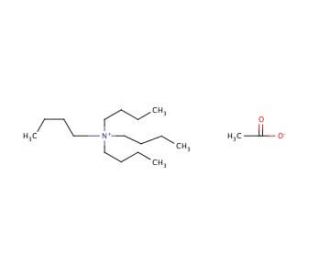

Tetrabutylammonium acetate (CAS 10534-59-5)
QUICK LINKS
Tetrabutylammonium acetate (TBAc) is a versatile quaternary ammonium salt widely used in organic synthesis and various scientific research applications. This colorless, odorless, and hygroscopic solid is soluble in both organic solvents and water. Its broad range of uses includes serving as a catalyst, chelating agent, and reagent for synthesizing diverse compounds. TBAc finds applications in fields such as biochemistry, pharmacology, and medicinal chemistry. In scientific research, TBAc plays a role as a catalyst, chelating agent, and reagent for compound synthesis. Its applications span the synthesis of organic compounds like polymers, dyes, and pharmaceuticals. It has been employed as a catalyst for peptide and protein synthesis, as well as for the synthesis of sugar derivatives. Additionally, TBAc has proven valuable in the production of various drugs, including antifungal agents, antibiotics, and anti-cancer agents. As a quaternary ammonium salt, TBAc acts as a Lewis acid and readily forms Lewis adducts with different substrates. It exhibits the ability to form hydrogen bonds with other molecules, allowing it to act as a chelating agent. Moreover, TBAc has demonstrated effectiveness in promoting ester hydrolysis, a critical step in numerous organic reactions. The alkynylation of carbonyl compounds with trimethylsilylacetylenes is a notable catalytic reaction facilitated by TBAc. This reaction leads to the formation of propargylic alcohols in good yields. TBAc′s catalytic properties make it particularly useful in this process.
Tetrabutylammonium acetate (CAS 10534-59-5) References
- Anionic ring-opening polymerization of beta-alkoxymethyl-substituted beta-lactones. | Adamus, G. and Kowalczuk, M. 2008. Biomacromolecules. 9: 696-703. PMID: 18179174
- [Not Available]. | Baylocq, D., et al. 1987. Talanta. 34: 515-7. PMID: 18964349
- Palladium(II)-Catalyzed Site-Selective C(sp3)-H Alkynylation of Oligopeptides: A Linchpin Approach for Oligopeptide-Drug Conjugation. | Liu, T., et al. 2017. Angew Chem Int Ed Engl. 56: 10924-10927. PMID: 28714148
- Understanding the Inhibiting Effect of Small-Molecule Hydrogen Bond Donors on the Solubility of Cellulose in Tetrabutylammonium Acetate/DMSO. | Bengtsson, J., et al. 2017. J Phys Chem B. 121: 11241-11248. PMID: 29172515
- Kinetic analysis of tautomer forms of aromatic-urea compounds with acetate ions: solvent effect of excited state intermolecular proton transfer. | Matsumoto, H., et al. 2018. Photochem Photobiol Sci. 17: 561-569. PMID: 29616691
- An Energy-Efficient One-Pot Swelling/Esterification Method to Prepare Cellulose Nanofibers with Uniform Diameter. | Song, Y., et al. 2018. ChemSusChem. 11: 3714-3718. PMID: 30188012
- Conformation and Visual Distinction between Urea and Thiourea Derivatives by an Acetate Ion and a Hexafluorosilicate Cocrystal of the Urea Derivative in the Detection of Water in Dimethylsulfoxide. | Tarai, A. and Baruah, JB. 2017. ACS Omega. 2: 6991-7001. PMID: 31457282
- Synthesis of silyl formates, formamides, and aldehydes via solvent-free organocatalytic hydrosilylation of CO2. | Murata, T., et al. 2020. Chem Commun (Camb). 56: 5783-5786. PMID: 32322865
- Evaluation of Ionic Liquids and Ionic Liquids Active Pharmaceutical Ingredients Inhibition in Elastase Enzyme Activity. | Mota, FAR., et al. 2021. Molecules. 26: PMID: 33401768
- Dissolution behavior of cellulose in a novel cellulose solvent. | Lin, L. and Tsuchii, K. 2022. Carbohydr Res. 511: 108490. PMID: 34952277
- All-Inorganic Perovskite Solar Cells with Tetrabutylammonium Acetate as the Buffer Layer between the SnO2 Electron Transport Film and CsPbI3. | Zhong, H., et al. 2022. ACS Appl Mater Interfaces. 14: 5183-5193. PMID: 35073689
- Preparation of flexible and UV-blocking films from lignin-containing cellulose incorporated with tea polyphenol/citric acid. | Shao, H., et al. 2022. Int J Biol Macromol. 207: 917-926. PMID: 35364193
- Direct Synthesis of 3-Aryl Substituted Isocoumarins and Phthalides through Palladium Acetate Catalyzed C(sp2)-H Activation in Ionic Liquids. | Aloia, A., et al. 2022. Chemistry. 28: e202202350. PMID: 35997238
- Synthesis of Enamines, Aldehydes, and Nitriles from CO2: Scope of the One-Pot Strategy via Formamides. | Nakaoka, K., et al. 2022. J Org Chem.. PMID: 36099541
Ordering Information
| Product Name | Catalog # | UNIT | Price | Qty | FAVORITES | |
Tetrabutylammonium acetate, 25 g | sc-258214 | 25 g | $98.00 |
